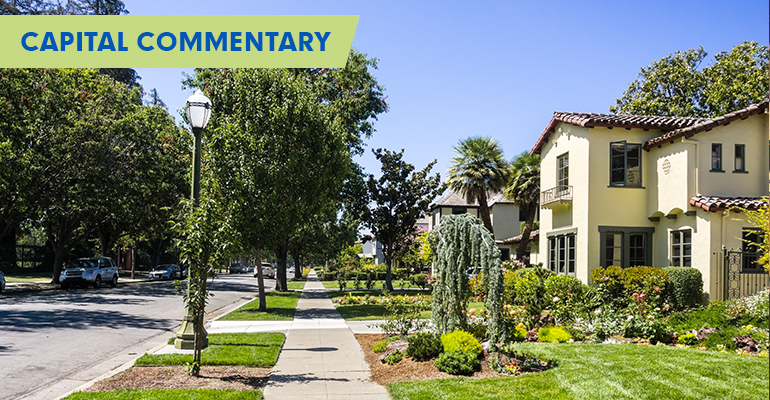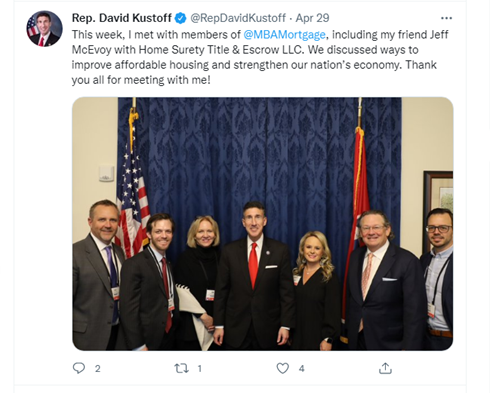
While much of the focus on home affordability centers on a shortage of homes or — more recently — rising interest rates, there are other steps policymakers might take to lower the cost of homeownership.
Capital Commentary explores appraisal modernization, cross-subsidization and tax incentives as approaches to address the high cost of becoming, and remaining, a homeowner. And our contest measures your insight into what are and aren’t affordable communities in which to purchase a home.
1. New-Style Appraisals Might Cut Fees but Increase Risks
The COVID-19 pandemic only confirmed what was long suspected by real estate experts: The residential appraisal process needs modernization. Why?
- Too few: There was already a shortage of licensed appraisers before the pandemic. The ongoing rapid pace of home sales only exacerbated the trend.
- Too alike: Whites comprise 85% of appraisers; their average age is over 50 and two-thirds are men. Not exactly representative of America today.
- Allegations of bias: The Biden administration’s Property Appraisal and Valuation Equity (PAVE) interagency task force was established to address concerns that homes in minority neighborhoods were undervalued due to appraiser bias.
Modernizing appraisals has already begun. Consider these alternatives to the traditional appraisal:
- Waivers: The GSEs have a wealth of historical data they can tap into when valuing homes, and today about 12% of home purchase loans qualify for appraisal waivers.
- Desktop appraisals: With this approach, licensed appraisers certify their work but never visit the property. During the pandemic, desktop appraisals could be used for loans up to 97% LTV. The GSEs are currently restricting desktop appraisals to purchase money transactions for one-unit properties occupied by the borrower with LTVs up to 90%. An online floorplan is also required.
- Hybrid appraisals: Combine a desktop appraisal with a real estate professional visiting and photographing the property.
The alternatives might save borrowers time and money but at what cost?
Modernization comes with risks that could be costly to homeowners, insurers, investors and taxpayers.
Mortgage insurers, on the hook for first loss on loans with LTVs above 80%, are appropriately nervous about any potential expansion of desktop appraisals — at least without mandating a home inspection.
The point was driven home in a recent Philadelphia Inquirer article about the risks homebuyers may face without ordering a home inspection first.
“The woman had just bought a house an investor flipped in Montgomery County. She skipped a home inspection to compete against other buyers, and a couple of months ago, she asked inspector Ben Poles to take a look.
“Poles … filled up the tub in a second-floor bathroom. The water didn’t get hot. When he went downstairs to investigate the cause, he saw that wasn’t the homeowner’s biggest problem: Water was pouring through the ceiling, and the drywall was coming apart.
“When I was borrowing paper towels from the neighbors, I was thinking: This is why you get an inspection before you buy the house,” he said. “Because now it’s on you to fix things.”
Without inspections, home buyers could wake up in their new home only to find leaky roofs, warped floors, termite damage or cracks in their foundation.
An appraiser sitting in his office studying a home’s online floorplan won’t find any evidence of these problems on the internet.
In their haste to solve the appraiser problem, GSEs and their regulator, the Federal Housing Finance Agency, should exert caution to ensure the appraiser gets the value right by requiring a professional inspection if any traditional appraisal shortcuts are used.
2. Give Borrowers Options for Using GSE Subsidies
Borrowers should choose how to use cross-subsidies provided by Fannie Mae and Freddie Mac, argue four housing experts in a new paper for the Urban Institute.
Details: Some borrowers might need a lower monthly mortgage payment; others need help in making a down payment or would prefer some funds in reserve to cover the unexpected expenses of being a homeowner.
Each of those options should be on the table for lenders to offer to borrowers, according to the report’s authors.
How cross-subsidies work: GSEs “broaden access (to homeownership) by cross subsidizing the loans they guarantee, charging some borrowers more than the GSEs need to achieve their targeted return so they can charge others less, increasing the number of those who can afford a mortgage,” explain the authors in “How Freddie and Fannie Can Use Pricing to Expand Affordable Homeownership.”
Which loans provide subsidies? Higher prices on investor loans, cash-out refinances and second homes can generate the revenues to cross-subsidize.
Raise prices, bolster subsidies, increase options: The paper suggests Fannie and Freddie should increase their cross-subsidies to the neediest buyers by “targeting the highest price for the non-mission loans they can charge before losing enough of that business that their revenues decline.”
- Lower rates on mortgages shouldn’t be the only way to use subsidies.
- Many borrowers who could make mortgage payments lack sufficient funds for a down payment. Others don’t have enough savings to cover their housing expenses “under even modest financial stress.”
3. MI Deduction at Risk Unless Congress Acts
Many moderate-income borrowers may face higher costs of homeownership if Congress doesn’t act soon to extend the tax deduction for mortgage insurance premiums.
The deduction, which applies equally to MI premiums associated with private MI or government agencies (FHA, VA, RHS), has benefited taxpayers since 2007. But it expired in 2021.
The deduction is limited to couples with incomes no higher than $100,000 per year or individuals earning no more than $50,000.
We’ve been here before: While the deduction was created 15 years ago, it has never been made permanent. Congress most recently extended it in December 2020.
A better solution: The Middle Class Mortgage Insurance Premium Act aims to improve the deduction by making it a permanent part of the tax code and doubling the income limits so more moderate-income families can use the deduction.
- MI will be an increasingly important tool for lenders as home prices continue to soar.
- Nearly 60% of buyers using Arch MI are first-time home buyers.
The House bill, H.R. 6109, was referred to the Ways and Means Committee.
Its newest co-sponsor, Rep. David Kustoff, R-TN, was persuaded to support the bill after visiting Arch MI’s Nashville-based Account Manager Kim Miller during the recent Mortgage Bankers Association’s National Advocacy Conference. (Miller is to the immediate left of Rep. Kustoff — sporting a red tie — in the tweet below.)
The Senate bill, S. 3590, was referred to the Senate Finance Committee.

Grassroots advocacy: Arch MI employees have rallied to support these bills, sending more than 100 letters to their House and Senate members urging support for the legislation.
Want to join the advocacy effort? We are here to help. Email me at [email protected] for information about identifying your representatives in Congress and suggested ways to make a case for expanding and making the MI premium deduction permanent.
4. USMI Head Moves On
Lindsey Johnson, who has led the U.S. Mortgage Insurers (USMI®) trade association since 2015, will be the new President and CEO of the Consumer Bankers Association beginning in early July.
Lindsey has served the industry capably and earned the respect of not only mortgage insurance industry executives but policymakers and consumer-focused leaders, alike.
“Lindsey brings to CBA nearly two decades of advocacy and strategic leadership experience. With a depth of financial services knowledge and a proven record of bipartisan advocacy, Lindsey is just the leader we were looking for to promote the work of our member banks, advance common-sense policy solutions and champion our industry and the customers we serve,” said CBA Board Chair Michelle Lee, Head of Regional Banking at Wells Fargo.

For the record, Arch MI is not a member of USMI, but company executives highly regard Lindsey’s accomplishments and dedication to the industry.
5. Contest #24: Ranking Communities by Affordability
Home prices are rising just about everywhere across the U.S., making homeownership increasingly unaffordable. One measure of determining affordability — and one that recently pushed metro Atlanta homes into the unaffordable category — is whether the average monthly mortgage payment is 30% or less of the average resident’s income.
For our latest contest, using the 30% of average income measure above, rank the following four metropolitan areas from most-to-least affordable to be entered into our drawing for an Arch MI Capital Commentary mug and saucer.
- Greensboro-High Point, NC.
- Philadelphia-Camden-Wilmington (PA, NJ, DE).
- St. Louis, MO.
- Memphis, TN.
To enter, click on this email link: [email protected] with your rankings of the cities, starting with the most affordable and ending with the most expensive for metro area residents.
6. Answer to Contest #23: On the Move
The previous contest asked readers to select both the No. 1 relocation city for new college graduates and the subset of Republicans from that cohort, according to a recent study by Axios-Generation Lab Next Cities Index. (The survey’s creator was specifically unmentioned in the earlier newsletter.)
- Seattle is the most-desired post-graduation destination for college students. New York City, Los Angeles, Denver, Colorado and Boston filled out the top five.
- Republicans, however, favored Austin, frequently considered the most progressive city in Texas. It proves that even conservatives want to have a good time after college before settling into a more staid lifestyle later in adulthood.

About Arch MI’s Capital Commentary
Capital Commentary newsletter reports on the public policy issues shaping the housing industry’s future. Each issue presents insights from a team led by Kirk Willison.
About Arch MI’s PolicyCast
PolicyCast — a video podcast series hosted by Kirk Willison — enables mortgage professionals to keep on top of the issues shaping the future of housing and the new policy initiatives under consideration in Washington, D.C., the state capitals and the financial markets.
Stay Updated
Sign up to receive notifications of new Arch MI PolicyCast videos and Capital Commentary newsletters.